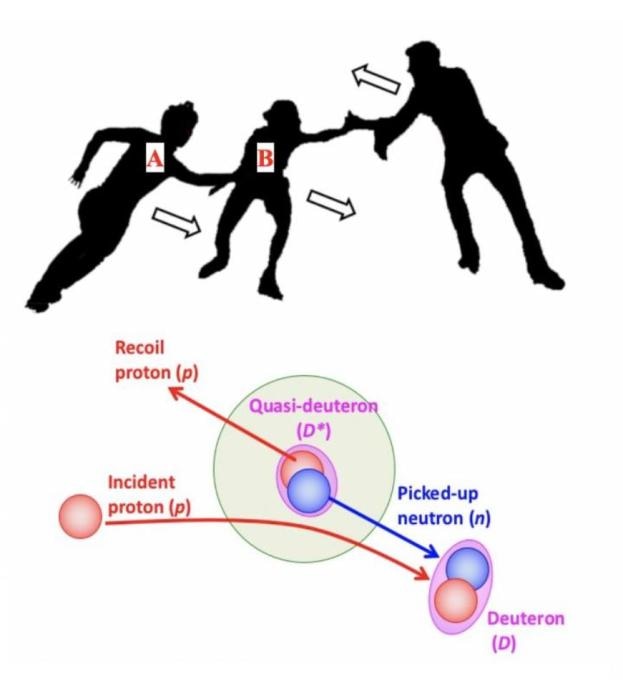Dec 20 2018
At the center of atoms protons and neutrons are held together by a nuclear force. This nuclear force includes a non-central component, that is, the tensor force, which relies on the relative position and spin of the interacting particles.
 Schematic representation of the experimental method used to observe strongly correlated neutron and proton pairs in oxygen-16 nuclei. The top figure shows an approaching skater with a matching velocity (Skater A, left), smoothly grabbing Skater B (center) from a spinning pair of skaters, which is an analogy for the pick-up of a neutron from a strongly correlated proton-neutron pair by an incident proton—shown in the bottom figure. The outgoing deuteron was analyzed by the high-resolution Grand Raiden spectrometer at Osaka University, while the recoiling proton was detected by an array opposite the spectrometer. (Image credit: Osaka University)
Schematic representation of the experimental method used to observe strongly correlated neutron and proton pairs in oxygen-16 nuclei. The top figure shows an approaching skater with a matching velocity (Skater A, left), smoothly grabbing Skater B (center) from a spinning pair of skaters, which is an analogy for the pick-up of a neutron from a strongly correlated proton-neutron pair by an incident proton—shown in the bottom figure. The outgoing deuteron was analyzed by the high-resolution Grand Raiden spectrometer at Osaka University, while the recoiling proton was detected by an array opposite the spectrometer. (Image credit: Osaka University)
Although the salience of the tensor force has been noted in the binding energies of light particles, to date, their influence on nuclear structure has not been analyzed in a more direct way. Earlier experiments in this area have revealed either the potential to identify the required particles, or the resolution needed to investigate this nuclear force component. Yet, none of them have demonstrated both the resolution and the potential to link the noted large momentum transfer of the proton-neutron pairs (or nucleon pair) to nuclear structure.
Currently, an international research partnership involving Osaka University has come up with the first evidence on the association between strongly correlated proton-neutron pairs in an atomic nucleus caused by the nuclear structure and the tensor interactions. A proton scattering experiment was used by the scientists to detect the strong interaction of proton-neutron pairs with moderate energy resolution of the final states. They could demonstrate the dominance of specific nuclear structures by measuring the simultaneous episodes of travel of protons and deuterons (particles made of one proton and one neutron) in opposite directions. The results have been reported in Physical Review Letters.
The behavior we have detected can be likened to a pair of skaters executing a spin—one of them represents a proton and the other represents a neutron. If a third skater (another proton) approaches at the correct velocity and picks up the neutron, they travel off together in one direction and the effect of them moving off causes the original proton to travel in the opposite direction. Detecting and analyzing such an event leads to information on the nuclear structure.
Hooi Jin Ong, Study Author, Osaka University.
Our data, acquired on the GRAF beam line at the Osaka cyclotron facility, are the first to demonstrate this behavior at large momentum transfer. We hope that our findings will be useful not only to nuclear physicists, but also to researchers working in a variety of fields, particularly astrophysics.
Satoru Terashima, Study First Author, Osaka University.
Predictions are that better insights into the internal structures of neutron stars and other celestial bodies can be gained by improving knowledge of the effect of the neutron and proton pairing on the nuclear structure, that is, the energy levels and the magic number (the number of protons and neutrons that offers substantially higher stability to nuclei compared to other combinations).